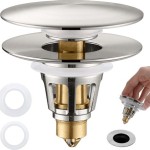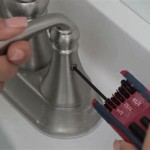Understanding UPC Compliance for Bathroom Sinks
Uniform Plumbing Code (UPC) compliance is a crucial aspect of any plumbing installation, including bathroom sinks. The UPC is a widely adopted model code developed by the International Association of Plumbing and Mechanical Officials (IAPMO). It establishes minimum regulations for plumbing systems, ensuring public health, safety, and welfare through safe and sanitary plumbing practices. This article will delve into the significance of UPC compliance for bathroom sinks, outlining key areas of focus and detailing the benefits of adhering to these established standards.
The primary goal of the UPC is to create a standardized framework for plumbing installations, regardless of location. Without such a code, consistency in plumbing practices would be absent, potentially leading to unsafe conditions and health hazards. The code covers a comprehensive range of plumbing components, including materials, design, and installation procedures for everything from water supply systems to drainage and venting systems. By adhering to the UPC, plumbers and building owners can guarantee that their plumbing systems meet a certain baseline level of safety and performance.
For bathroom sinks specifically, UPC compliance addresses several critical areas. These areas encompass the materials used in the sink's construction, the design of the drainage system, and the installation requirements that ensure proper functionality and prevent potential issues such as leaks or backflow. Ignoring these regulations can result in consequences ranging from minor inconveniences to serious health risks.
Key Considerations for UPC Compliant Bathroom Sinks
Several key factors contribute to ensuring a bathroom sink is UPC compliant. These factors relate to the materials of construction, the drain assembly, and overall design geared toward hygiene and water conservation.
Material Standards: The UPC mandates specific material standards for bathroom sinks to ensure durability, hygiene, and resistance to corrosion. Materials commonly used for bathroom sinks, such as vitreous china, stainless steel, and cast iron, must meet certain quality benchmarks. These benchmarks often involve testing for lead content, chemical resistance, and structural integrity. For example, the UPC restricts the amount of lead permitted in plumbing fixtures to minimize the risk of lead contamination in drinking water. Similarly, the materials must be able to withstand the constant exposure to water and cleaning agents without degrading or leaching harmful substances. Compliance with these material standards guarantees that the sink is safe for long-term use and won't compromise water quality.
Drain Assembly and Trap Requirements: The drain assembly, including the tailpiece, drain stopper, and P-trap, is a critical component of a bathroom sink. The UPC dictates the dimensions and materials of these components to ensure proper drainage and prevent sewer gases from entering the building. The P-trap, in particular, plays a crucial role in maintaining a sanitary environment. It's a curved section of pipe that retains a small amount of water, effectively creating a barrier against sewer gases. The UPC specifies the minimum and maximum trap seal depth to ensure the trap functions correctly. Additionally, the code outlines venting requirements to equalize pressure in the drainage system, preventing the trap from being siphoned dry. Non-compliance with these drain assembly requirements can result in unpleasant odors, potential health hazards, and drainage problems.
Overflow and Waste Fittings: An overflow is a small opening in the sink basin that prevents water from overflowing if the drain is blocked or the faucet is left running. The UPC stipulates that bathroom sinks equipped with overflows must have a properly designed and installed overflow system that effectively channels excess water into the drain. The waste fitting, also known as the drain flange, connects the sink to the drainpipe. The UPC outlines the specifications for the waste fitting, ensuring a watertight connection and preventing leaks. These specifications include dimensional requirements, material requirements, and installation procedures. A properly installed overflow and waste fitting are essential for preventing water damage and maintaining a sanitary bathroom environment.
The Importance of Proper Installation for UPC Compliance
Even if a bathroom sink and its components are UPC compliant, improper installation can negate those benefits and lead to code violations. Proper installation is just as important as using compliant materials and fixtures. Several aspects of installation directly impact UPC compliance.
Secure Mounting and Support: The sink must be securely mounted and supported to prevent movement or instability. The UPC often references specific guidelines for supporting different types of sinks, such as wall-mounted sinks, pedestal sinks, and undermount sinks. These guidelines may include recommendations for the type and spacing of brackets, anchors, and fasteners used to secure the sink to the wall or countertop. Insufficient support can lead to cracks, leaks, and even complete failure of the sink, potentially causing water damage and creating a safety hazard. The installation must be performed by a qualified professional who understands these requirements and can ensure the sink is properly supported.
Water Supply Connections: The water supply lines connecting to the faucet must adhere to UPC standards for materials, size, and connection methods. The UPC may require the use of specific types of pipe, such as copper or PEX, and specify the appropriate fittings and valves. It also outlines requirements for installing shut-off valves to allow for easy maintenance and repairs without shutting off the entire water supply. Incorrectly installed water supply connections can lead to leaks, reduced water pressure, and potential water contamination. Furthermore, the UPC mandates backflow prevention devices in certain situations to protect the potable water supply from contamination. These devices prevent non-potable water from flowing back into the drinking water system.
Drain Line Connections and Slope: The drain line connecting the sink to the building's drainage system must be properly installed with the correct slope to ensure adequate drainage. The UPC specifies the minimum slope required for drain lines to prevent clogs and backups. It also outlines the allowed materials for drain lines, such as PVC or ABS, and specifies the appropriate fittings and connections. Proper venting is also crucial for drain line function. An improperly vented drain line can create a vacuum, causing the P-trap to siphon dry and allowing sewer gases to enter the building. The UPC provides detailed guidelines for venting requirements, including the size and location of vent pipes. Failing to adhere to these drain line and venting requirements can result in slow drainage, clogs, unpleasant odors, and potential health hazards.
Benefits of Using UPC Compliant Bathroom Sinks
Choosing and installing UPC compliant bathroom sinks provides numerous benefits, ranging from ensuring safety and sanitation to increasing property value and avoiding legal issues.
Ensuring Safety and Sanitation: The primary benefit of UPC compliance is the assurance of safety and sanitation. By adhering to the code's requirements for materials, design, and installation, building owners can minimize the risk of water contamination, leaks, and exposure to harmful substances. The UPC's focus on lead-free materials, proper drainage, and backflow prevention helps protect the health of occupants. A UPC compliant bathroom sink provides peace of mind, knowing that the plumbing system is designed and installed to meet the highest standards of safety and hygiene.
Avoiding Code Violations and Penalties: Failure to comply with the UPC can result in code violations, fines, and even legal action. Local jurisdictions typically enforce the UPC through inspections and permit processes. If a plumbing installation is found to be non-compliant, the building owner may be required to make costly repairs or replacements to bring the system up to code. In some cases, non-compliance can also lead to delays in construction projects or prevent the issuance of occupancy permits. Choosing UPC compliant bathroom sinks and ensuring proper installation helps avoid these potential problems and ensures that the plumbing system meets all applicable regulations.
Increasing Property Value and Appeal: UPC compliance can also enhance the value and appeal of a property. Potential buyers are increasingly aware of the importance of code compliance and may view a non-compliant plumbing system as a liability. A property with a UPC compliant plumbing system is more likely to pass inspection and be considered a safe and well-maintained investment. Additionally, a modern and efficient plumbing system can improve the overall aesthetics and functionality of a bathroom, making the property more attractive to potential buyers or renters.
UPC compliance for bathroom sinks is not merely a technical requirement; it's a crucial aspect of ensuring safe, sanitary, and efficient plumbing systems. By understanding the key areas of focus and adhering to the standards outlined in the UPC, both plumbers and building owners can contribute to a healthier and more sustainable built environment. The benefits of compliance extend beyond avoiding code violations, encompassing improved safety, increased property value, and peace of mind.

Buy Whole China Upc Bathroom Sinks In Undermould Installed At Usd 15 Global Sources

Upc Porcelain Ceramic Sink Wash Basin Undermount Bathroom China Kitchen Bowl Made In Com

Matt Solid Surface Upc Bathroom Vanity Sink Basin With Metal Support China Made In Com

22 Inch Vanity Upc Porcelain Ceramic Sink Wash Basin Undermount Bathroom In White Under China Sanitary Ware Made Com

Why Should You Care If A Bathroom Faucet Has Upc Cupc Certificatio Lulani

Kraus Elavo 19 1 4 In Oval Porcelain Ceramic Undermount Bathroom Sink White With Overflow Drain Kcu 272 The Home Depot

Modern Ceramic Countertop Upc Certificate Bathroom Vanity Sink Basin China Cupc Bowl Made In Com

Eastvita Bathroom Sink Faucet Widely Brushed Nickel 3 Hole With Stainless Steel Pop Up Drain And Upc Lead Free Hose Com

17 3 8 X 14 1 4 White Oval Undermount Porcelain Bathroom Sink With Overflow

Karran Quattro Matte White Acrylic 23 In Oval Bathroom Vessel Sink With Faucet And Drain Black Qm160wh412mb The Home Depot






